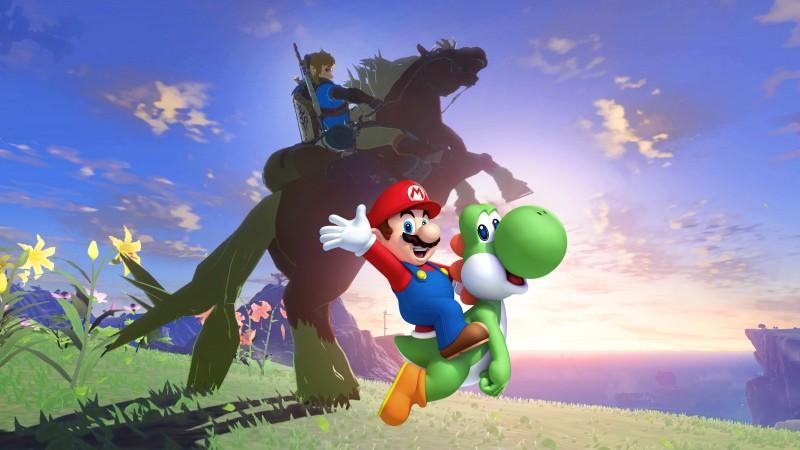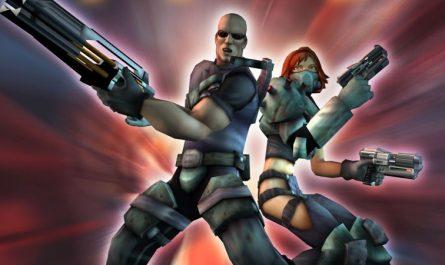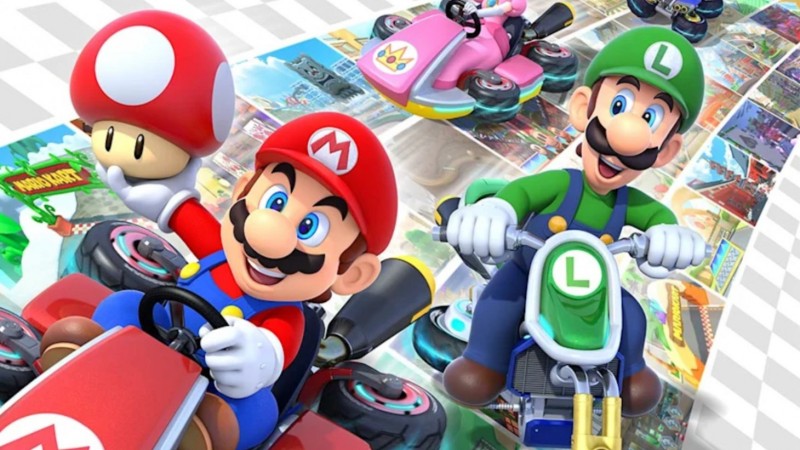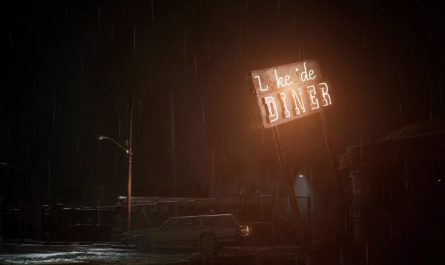Ever since Nintendo’s flagship franchise burst onto the scene nearly 40 years ago, the Super Mario Bros. franchise has maintained its popularity, relevance, and status since its revolutionary debut entry. But it’s not alone; the Legend of Zelda series, which started around that time, also remains a genre leader all these decades later. During our discussions with Nintendo during our Super Mario Bros. Wonder cover story (and other interviews earlier this year), we tried to drill into why these franchises – in particular, the Mario franchise – have maintained their popularity and level of quality while so many other series have struggled to hold onto it for even a fraction of the time.
According to Mario series producer Takashi Tezuka, the tenure of the staff involved is a key part of keeping series like Mario and The Legend of Zelda as industry leaders. “May of them have been working on these franchises for a long time,” he says. “For example, Mr. [Eiji] Aonuma became a part of the Zelda team at some point and has been there throughout, and for Mario, it’s myself! I think something that’s very important to the Mario series, of course, is the level-design philosophy.”
Super Mario Bros. (1985)
That level-design philosophy, as well as an emphasis on iteration, has been instrumental in keeping the Super Mario franchise as the premier platforming franchise since its 1985 debut. “When we’re creating every individual course, we just keep iterating, we keep looking, working on it until we believe that it’s interesting; if it’s interesting to play or fun to play, it’s because someone made it fun to play,” Tezuka says. “A major characteristic of side-scrolling 2D games is that you can still make changes to the course during the final stage of development. Of course, this cannot be achieved without excellent course editing tools. I think it’s important to have tenacity and continue to strive for improvement until the very end, referencing feedback from focus groups.”
For Mario creator Shigeru Miyamoto, the easy-to-understand gameplay is largely to thank for the overall-wearing plumber’s continued relevance. “It’s very intuitive in that when you see a hole in the ground, you know to jump over it; when there’s a high place, you want to climb it,” Miyamoto told Game Informer at the premiere of The Super Mario Bros. Movie earlier this year. “When that intuitive and direct connection happens, then people are encouraged to say, ‘I want to try this. I want to go there. I want to challenge this.’ And then, through that, they’re rewarded with other gameplay experiences. That feedback it creates, I think that’s the kind of gameplay that Mario is, and this is probably why it can be so appealing to so many different people across both ages, but also across cultures and countries.”
Super Mario 64 (1996)
In appealing to numerous generations, Mario is now created, at least in part, by developers who grew up playing the earlier games in the series. While Tezuka still values the tenure that longtime Nintendo employees such as himself bring, he also wanted to leverage that new blood in the creation of Super Mario Bros. Wonder. “When looking at creating a new Mario title, we actually went ahead and brought in a lot of younger people into our staff,” Tezuka says. “There are people who hadn’t made a Super Mario game before; they’re our target audience. They’re, of course, developers, but they’re also people who enjoy playing games, and so they wanted to create something that they themselves would enjoy as gamers.”
This new crop of developers melded with the long-standing Mario developers to challenge preconceived notions. “It’s really this great mixture of people who have been veterans in the series and also new and upcoming developers, and they are open to fielding the feedback from these new developers,” Super Mario Bros. Wonder director Shiro Mouri says.
“We never, ever, ever ignore the feedback that we get from our new staff members,” Tezuka chimes in. “And when I present an idea myself, they really are quite honest in saying, ‘Yeah, I don’t like that,’ or ‘I do like that.’ I think that’s a really beneficial environment that we have.”
Super Mario Bros. Wonder (2023)
In addition to serving as series producer of the Super Mario franchise, Tezuka directed some of the most formative Mario games, including Super Mario Bros. 3, Super Mario World, and Super Mario World 2: Yoshi’s Island. Tezuka was also heavily involved with the Legend of Zelda franchise, even directing two of the most beloved titles in the series’ early years, A Link to the Past and Link’s Awakening, in addition to co-directing the first game on NES. Following the SNES era, Tezuka moved into a supervisory and production role, and Eiji Aonuma slotted in to direct a run of games beginning with Ocarina of Time and Majora’s Mask. However, following the release of Twilight Princess, Aonuma also relinquished directorial duties in favor of supervisor and producer roles within the series.
To this day, Aonuma oversees the Legend of Zelda series as producer, but like Tezuka and his team, he has worked to incorporate newer developers into the mix, but he still relies on his experience to ensure that no matter what form the Zelda franchise takes, the game still feels like a Zelda game. “[We always make] sure that Zelda-ness or that Zelda feel is really in the game,” Aonuma told Game Informer at the launch of The Legend of Zelda: Tears of the Kingdom earlier this year. “Even if a game like Breath of the Wild has really big changes in it, as long as the fans and the players are able to feel that this is a Zelda game at its core when they play the game, that is something that is really important to us when meeting fans’ expectations.”
The Legend of Zelda (1986)
Hidemaro Fujibayashi has slotted into that Zelda director spot for many recent titles, including Skyward Sword, Breath of the Wild, and Tears of the Kingdom. He attributed keeping the essence of the Zelda franchise intact regardless of the direction the core gameplay goes, but much like his Mario counterparts, the development-team makeup is crucial to keeping the franchise fresh over the decades.
“I think some of it has to do with the fact that we have a unique and diverse set of people in our teams in that they have all kinds of hobbies; it’s not only just people who play games,” Fujibayashi told Game Informer at the launch of The Legend of Zelda: Tears of the Kingdom earlier this year. “And they have these hobbies that they enjoy, and they take that fun that they experience in their real lives and try to drop the essence of those elements into the games that they create. Having that environment where they can freely develop and use their creativity to drop these into the games they’re working on, I think, plays a critical role for very diverse and unique games to be created.”
The Legend of Zelda: Ocarina of Time (1998)
But getting to the core of Zelda’s longstanding relevance circles back to how Nintendo develops games, and likely speaks to the larger question related to the Mario franchise, as well. Aonuma referenced how Fujibayashi wasn’t able to implement everything he wanted to in Skyward Sword, but circled back on some of those ideas in the creation of Tears of the Kingdom. Aonuma pointed to that as a persistent philosophy at Nintendo rather than a one-off example.
“When it comes to Nintendo’s development, I think we have a bit of tenacity with the ideas that we come up with,” Aonuma said. “This is something I think Mr. Miyamoto has said in the past, but when you have an idea and try to make it work, and it doesn’t work out, you don’t give up on that idea. Instead, just wait for the right opportunity to arrive. Those ideas – and I think this is true of our developer – stick around in their heads; they keep them with them as they continue in their work. When those pile up, and the right opportunity presents itself, we find the opportunity to implement those ideas.”
The Legend of Zelda: Breath of the Wild (2017)
Clearly, whatever Nintendo is doing is working. The Legend of Zelda: Breath of the Wild launched in March 2017 and took home many Game of the Year awards (including our own), before The Legend of Zelda: Tears of the Kingdom launched in May of this year to widespread critical acclaim. Super Mario Bros. Wonder is the first 2D platforming title the franchise has produced for home consoles in 11 years, but all signs point to it being an excellent evolution of the series’ familiar conventions. We’ll have to wait until later this week to see if it lives up to this long-standing legacy and continued Seal of Quality, but Nintendo shows no signs of slowing down anytime soon.
For more on Super Mario Bros. Wonder, be sure to visit our hub through the banner below for exclusive content about Nintendo’s next highly anticipated 2D platformer. To read the full interview with Shigeru Miyamoto and Koji Kondo, head here. For the full interview with Eiji Aonuma and Hidemaro Fujibayashi, go here.
Ever since Nintendo’s flagship franchise burst onto the scene nearly 40 years ago, the Super Mario Bros. franchise has maintained its popularity, relevance, and status since its revolutionary debut entry. But it’s not alone; the Legend of Zelda series, which started around that time, also remains a genre leader all these decades later. During our discussions with Nintendo during our Super Mario Bros. Wonder cover story (and other interviews earlier this year), we tried to drill into why these franchises – in particular, the Mario franchise – have maintained their popularity and level of quality while so many other series have struggled to hold onto it for even a fraction of the time.
According to Mario series producer Takashi Tezuka, the tenure of the staff involved is a key part of keeping series like Mario and The Legend of Zelda as industry leaders. “May of them have been working on these franchises for a long time,” he says. “For example, Mr. [Eiji] Aonuma became a part of the Zelda team at some point and has been there throughout, and for Mario, it’s myself! I think something that’s very important to the Mario series, of course, is the level-design philosophy.”
Super Mario Bros. (1985)
That level-design philosophy, as well as an emphasis on iteration, has been instrumental in keeping the Super Mario franchise as the premier platforming franchise since its 1985 debut. “When we’re creating every individual course, we just keep iterating, we keep looking, working on it until we believe that it’s interesting; if it’s interesting to play or fun to play, it’s because someone made it fun to play,” Tezuka says. “A major characteristic of side-scrolling 2D games is that you can still make changes to the course during the final stage of development. Of course, this cannot be achieved without excellent course editing tools. I think it’s important to have tenacity and continue to strive for improvement until the very end, referencing feedback from focus groups.”
For Mario creator Shigeru Miyamoto, the easy-to-understand gameplay is largely to thank for the overall-wearing plumber’s continued relevance. “It’s very intuitive in that when you see a hole in the ground, you know to jump over it; when there’s a high place, you want to climb it,” Miyamoto told Game Informer at the premiere of The Super Mario Bros. Movie earlier this year. “When that intuitive and direct connection happens, then people are encouraged to say, ‘I want to try this. I want to go there. I want to challenge this.’ And then, through that, they’re rewarded with other gameplay experiences. That feedback it creates, I think that’s the kind of gameplay that Mario is, and this is probably why it can be so appealing to so many different people across both ages, but also across cultures and countries.”
Super Mario 64 (1996)
In appealing to numerous generations, Mario is now created, at least in part, by developers who grew up playing the earlier games in the series. While Tezuka still values the tenure that longtime Nintendo employees such as himself bring, he also wanted to leverage that new blood in the creation of Super Mario Bros. Wonder. “When looking at creating a new Mario title, we actually went ahead and brought in a lot of younger people into our staff,” Tezuka says. “There are people who hadn’t made a Super Mario game before; they’re our target audience. They’re, of course, developers, but they’re also people who enjoy playing games, and so they wanted to create something that they themselves would enjoy as gamers.”
This new crop of developers melded with the long-standing Mario developers to challenge preconceived notions. “It’s really this great mixture of people who have been veterans in the series and also new and upcoming developers, and they are open to fielding the feedback from these new developers,” Super Mario Bros. Wonder director Shiro Mouri says.
“We never, ever, ever ignore the feedback that we get from our new staff members,” Tezuka chimes in. “And when I present an idea myself, they really are quite honest in saying, ‘Yeah, I don’t like that,’ or ‘I do like that.’ I think that’s a really beneficial environment that we have.”
Super Mario Bros. Wonder (2023)
In addition to serving as series producer of the Super Mario franchise, Tezuka directed some of the most formative Mario games, including Super Mario Bros. 3, Super Mario World, and Super Mario World 2: Yoshi’s Island. Tezuka was also heavily involved with the Legend of Zelda franchise, even directing two of the most beloved titles in the series’ early years, A Link to the Past and Link’s Awakening, in addition to co-directing the first game on NES. Following the SNES era, Tezuka moved into a supervisory and production role, and Eiji Aonuma slotted in to direct a run of games beginning with Ocarina of Time and Majora’s Mask. However, following the release of Twilight Princess, Aonuma also relinquished directorial duties in favor of supervisor and producer roles within the series.
To this day, Aonuma oversees the Legend of Zelda series as producer, but like Tezuka and his team, he has worked to incorporate newer developers into the mix, but he still relies on his experience to ensure that no matter what form the Zelda franchise takes, the game still feels like a Zelda game. “[We always make] sure that Zelda-ness or that Zelda feel is really in the game,” Aonuma told Game Informer at the launch of The Legend of Zelda: Tears of the Kingdom earlier this year. “Even if a game like Breath of the Wild has really big changes in it, as long as the fans and the players are able to feel that this is a Zelda game at its core when they play the game, that is something that is really important to us when meeting fans’ expectations.”
The Legend of Zelda (1986)
Hidemaro Fujibayashi has slotted into that Zelda director spot for many recent titles, including Skyward Sword, Breath of the Wild, and Tears of the Kingdom. He attributed keeping the essence of the Zelda franchise intact regardless of the direction the core gameplay goes, but much like his Mario counterparts, the development-team makeup is crucial to keeping the franchise fresh over the decades.
“I think some of it has to do with the fact that we have a unique and diverse set of people in our teams in that they have all kinds of hobbies; it’s not only just people who play games,” Fujibayashi told Game Informer at the launch of The Legend of Zelda: Tears of the Kingdom earlier this year. “And they have these hobbies that they enjoy, and they take that fun that they experience in their real lives and try to drop the essence of those elements into the games that they create. Having that environment where they can freely develop and use their creativity to drop these into the games they’re working on, I think, plays a critical role for very diverse and unique games to be created.”
The Legend of Zelda: Ocarina of Time (1998)
But getting to the core of Zelda’s longstanding relevance circles back to how Nintendo develops games, and likely speaks to the larger question related to the Mario franchise, as well. Aonuma referenced how Fujibayashi wasn’t able to implement everything he wanted to in Skyward Sword, but circled back on some of those ideas in the creation of Tears of the Kingdom. Aonuma pointed to that as a persistent philosophy at Nintendo rather than a one-off example.
“When it comes to Nintendo’s development, I think we have a bit of tenacity with the ideas that we come up with,” Aonuma said. “This is something I think Mr. Miyamoto has said in the past, but when you have an idea and try to make it work, and it doesn’t work out, you don’t give up on that idea. Instead, just wait for the right opportunity to arrive. Those ideas – and I think this is true of our developer – stick around in their heads; they keep them with them as they continue in their work. When those pile up, and the right opportunity presents itself, we find the opportunity to implement those ideas.”
The Legend of Zelda: Breath of the Wild (2017)
Clearly, whatever Nintendo is doing is working. The Legend of Zelda: Breath of the Wild launched in March 2017 and took home many Game of the Year awards (including our own), before The Legend of Zelda: Tears of the Kingdom launched in May of this year to widespread critical acclaim. Super Mario Bros. Wonder is the first 2D platforming title the franchise has produced for home consoles in 11 years, but all signs point to it being an excellent evolution of the series’ familiar conventions. We’ll have to wait until later this week to see if it lives up to this long-standing legacy and continued Seal of Quality, but Nintendo shows no signs of slowing down anytime soon.
For more on Super Mario Bros. Wonder, be sure to visit our hub through the banner below for exclusive content about Nintendo’s next highly anticipated 2D platformer. To read the full interview with Shigeru Miyamoto and Koji Kondo, head here. For the full interview with Eiji Aonuma and Hidemaro Fujibayashi, go here.Read MoreGame Informer



